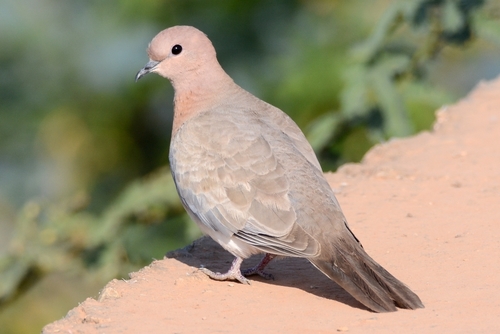
Laughing Dove
The Laughing Dove (Spilopelia senegalensis) is a small, slender dove known for its distinctive call, which sounds remarkably like human laughter. This species plays a significant ecological role as a seed disperser and is a common sight in many urban and rural environments. It holds cultural significance in various regions, often symbolizing peace and good fortune. It is well-adapted to human presence, thriving in gardens, parks, and agricultural areas.
25-27 cm
Length
40-45 cm
Wingspan
Least Concern
Conservation Status
Distribution
Native to Africa, the Middle East, and the Indian subcontinent. It has also been introduced to Western Australia. Populations are found across a wide altitudinal range, from sea level to around 2000 meters.
Lifespan
Typically 3-5 years in the wild, but can live longer in captivity.
Laughing Dove's Habitat
Habitat Types
Savannas, Open Woodlands, Grasslands, Agricultural Lands, Urban and Suburban Areas
Climate Zones
Tropical, Subtropical, Semi-arid
Adaptations
The Laughing Dove is well-adapted to drier environments and can tolerate high temperatures. It has a high tolerance for human disturbance, allowing it to thrive in close proximity to human settlements.
Variations
Several subspecies are recognized, differing slightly in plumage and size, reflecting adaptations to local conditions across their extensive range.
Appearance
Breeding Plumage
Plumage is relatively consistent throughout the year.
Seasonal Feather Changes
Minimal seasonal variation.
Sex Based Plumage Differences
Males and females have similar plumage, although males may have slightly more iridescence.
Notable Features
Rufous-brown upperparts with bluish-grey patches on the wings., Black-spotted necklace-like pattern on the upper breast., Pinkish underparts., Reddish orbital skin.
Diet and Feeding
Primary Foods
Seeds, Grains, Small Insects, Fallen Fruits
Foraging Behavior
Primarily forages on the ground, often in small flocks or pairs. It pecks at seeds and other food items from the soil surface.
Specializations
No specific physical specializations for feeding, but its generalist diet allows it to exploit a wide range of food sources.
Seasonal Diet Variations
Diet may shift slightly depending on seasonal availability of seeds and insects, with a greater reliance on seeds during drier periods.
Behavior
Social Structure
Often seen in pairs or small flocks, but can form larger aggregations at feeding sites or water sources.
Communication
Distinctive 'laughing' call., Soft cooing sounds during courtship., Wing-clapping during display flights.
Migration
Generally non-migratory, but may undertake local movements in response to food availability or rainfall.
Territorial or Group Behaviors
Pairs may defend a small territory around their nest, but are generally not highly territorial.
Conservation
Threats
Habitat Loss (due to agriculture and urbanization), Pesticide Use, Hunting (in some regions)
Protection Programs
Not subject to specific large-scale conservation programs due to its 'Least Concern' status.
Local National Laws
Protected under general wildlife legislation in many countries within its range.
Population Trend
Stable
Population Estimates
Global population is estimated to be very large, with millions of individuals.
Interesting Facts
Their 'laughing' call is a common sound in many African and Asian cities.
This vocalization is used for communication and territorial defense.
They are known to be quite tame and approachable.
This is likely due to their long association with human settlements.
They are very adaptable to a wide range of environmental conditions.
This is why they have been successfully introduced in areas outside their original range.
Faqs about Laughing Dove
What does a Laughing Dove eat?
Laughing Doves primarily eat seeds and grains, but also consume small insects and fallen fruits. They forage on the ground.
Where do Laughing Doves live?
They are found in Africa, the Middle East, the Indian subcontinent, and have been introduced to Western Australia. They inhabit savannas, open woodlands, grasslands, agricultural areas, and urban environments.
Are Laughing Doves endangered?
No, the Laughing Dove is classified as 'Least Concern' by the IUCN, meaning their population is currently stable and widespread.
Copyright @ Nature Style Limited. All Rights Reserved.
 English
English